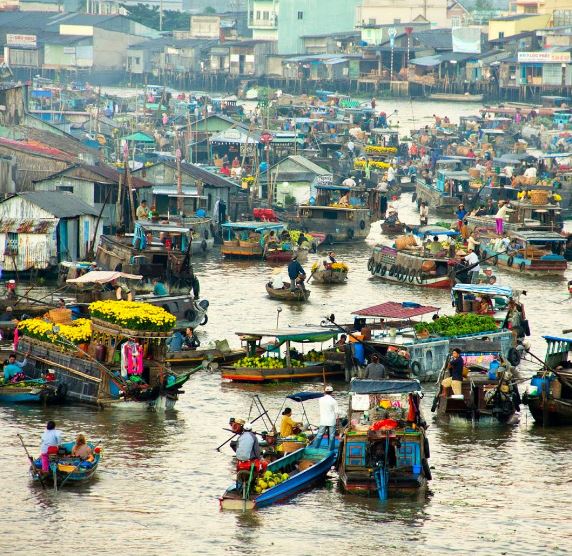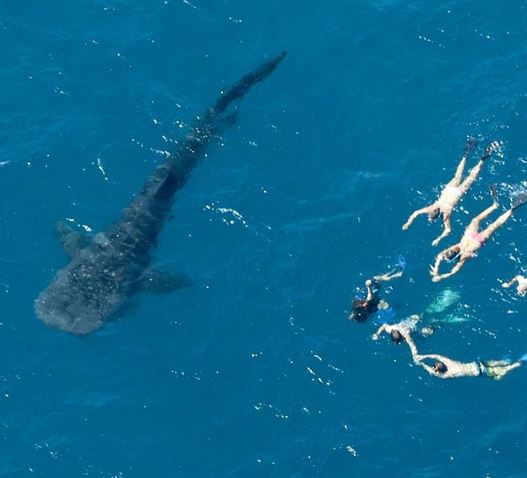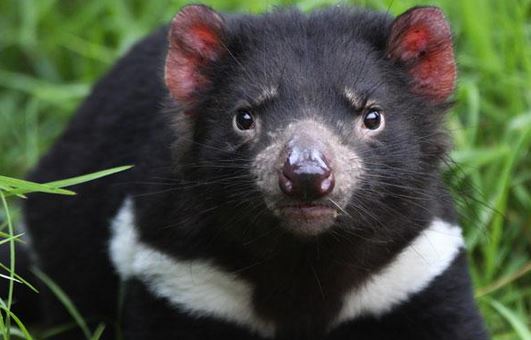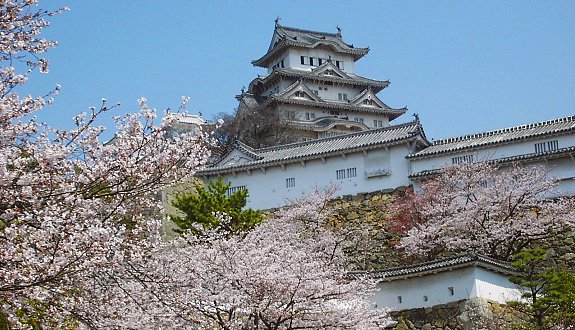Agriculture involving domestication of plants and animals was developed some 12,000 years ago. Identifying the exact origin of agriculture, however, remains difficult because the transition from hunter-gatherer societies began thousands of years before writing. Between about 8000 and 3500 BCE, increasing numbers of humans shifted to dependence on cultivated crops and domesticated animals for their subsistence. While westernized countries today often center on mega-farms and gigantic agricultural projects, many areas of the world still use centuries-old techniques handed down by their forefathers. The villages and rural regions of Indochina have kept alive those earlier farming methods. The “agri-adventures” below offer insights into the development of societies and communities as well as to the everyday connections we have with the food we eat.

Floating Vegetable Markets, Mekong Delta, Southern Vietnam
1. Rice Paddies, Luang Prabang, Laos
Rice is a vital staple for many across Southeast Asia. Outside Luang Prabang, you can explore an organic vegetable farm and rice fields. Many of us are generations removed from the land our forefathers understood. Here you have the opportunity to participate in a Living Farm experience that takes you through the 13 steps needed for growing, harvesting and cooking sticky rice, using age-old tools and methods. You step into someone else’s shoes and reconnect with the land as you also gain better appreciation of everyday life for these hardworking rural people. This experience can be incorporated into Myanmar, Cambodia & Laos: Minority Tribes of Indochina
2. Pepper Farm, Kep, Cambodia
The coastal countryside surrounding the city of Kep is incredibly scenic and dotted with traditional Khmer villages, seasonal rice paddies – and pepper! The well-known Kampot pepper plant is only produced in half a dozen districts of the Cambodian provinces of Kampot and Kep, and it is the first Cambodian product to enjoy the EU’s protected geographical status, which certifies the origin of regional foods. Visit an organic pepper farm nestling amid fruit and vegetable plantations in the heart of Cambodia’s famous pepper region. This experience can be enjoyed on our Rural Landscapes of Laos & Cambodia.
3. Floating Gardens, Inle Lake, Myanmar
The people of Inle Lake grow vegetables on floating islands, a collection of floating weed and water hyacinth. These ‘islands’ can be cut, dragged by boats and be sold like a piece of land. Locals grow vegetables and fruit in large beds are formed by extensive manual labor. The farmers gather lake-bottom weeds from the deeper parts of the lake and make them into floating beds anchored by bamboo poles. These gardens rise and fall with changes in the water level, and so are resistant to flooding. The constant availability of nutrient-laden water results in these gardens being incredibly fertile. Explore the many facets and traditions of the lake in our Myanmar journey.
4. Floating Vegetable Markets, Mekong Delta, Southern Vietnam
The Mekong River delta produces about half of Vietnam’s total agricultural output. Indeed, the region has recently been dubbed a ‘biological treasure trove’ for the more than 1,000 new species of plants that have been found in newly explored areas. The delta is known for its floating markets such as those in Phung Hiep and Cai Be. Farmers from the region bring their fresh fruits and vegetables to the markets. Countless boats take part in the floating market trade, even in locations not accessible by car. The largest and most popular floating market is in the city of Can Tho, where you can buy everything you need for your menu – from fresh fruits and vegetables, to meat, to rice wine. But you have to be early to catch the action at these markets. The biggest floating market in the delta, for example, is Phung Hiep, which is open between 4.00 am and 11.00 am. Cai Be, one of the many floating markets in southern Vietnam, was formed in the 19th century. Create your own Vietnam itinerary that includes the massive Mekong Delta in our Custom Vietnam Tour.
5. Organic Farms, Song Saaa Island, Cambodia
The Journeys of Change programs here provides guests with the opportunity to explore the organic farms of the island as well as other philanthropic projects. Guests learn about the work being done to promote a sustainable future for the people and places of the Koh Rong Archipelago. Participants will experience one of the last remaining untouched environments in tropical Southwest – with pristine sand beaches, swaying coconut palms and fringing coral reefs; while finding themselves energized by the beauty of the environment and spirit of the Archipelago’s people. Explore this beautiful island on our Thailand & Cambodia adventure.

Dive the Ningaloo Reef with the whale shark– the world’s largest fish.
Australia is old-world rainforests, sophisticated cities, unique railway journeys, extraordinary landscapes, stellar lodges and inns and an extravagance of cultural encounters. It is a brilliantly diverse destination that satisfies nearly every interest – from cosmopolitan Sydney to the rugged Northern Territory to eccentric Tasmania. In addition to the country’s well-known gems such as Uluru Ayers Rock and Kata Tjuta (The Olgas), and the Great Barrier Reef, make room for some lesser known adventures.
Save the Devil
Coles Bay, Tasmania
Some of you might remember the little whirling Tasmanian Devil from the Road Runner cartoons. This fabled creature is now in a battle to survive, and you can help. This is another example of how our guests make a difference simply by staying at a specific lodge. Saffire Freycinet is one such lodge. It has teamed up with Save the Tasmanian Devil Program, and is a key sponsor of the Menzies Research Institute’s quest to develop a vaccine for a disease that is decimating the species. The population of these marsupials has declined by more than 80 percent; and in the northeast region that number is about 95%. In addition to other support, the lodge also maintains a one-hectare, free-range devil enclosure – a sort of retirement home for mature devils that have been part of the breeding program. This enclosure provides a safe environment and high quality of life while also giving guests at lodge a unique opportunity to see Tasmanian devils in a natural setting. Southern Australia & Tasmania journey includes a stay at Saffire Freycinet.

Help save Australia’s tasmanian devils.
Tracking Dinosaurs
Mt Morgan
In a far corner of an old gold mine are the massive Mt Morgan fireclay caverns, which were excavated by miners more than a century ago for the purpose of lining the mine’s furnaces during the smelting process. The first evidence of dinosaur prints came only in the 1950s, some 30 years after the caverns were abandoned. Today more than 300 prints have been discovered located in the cavern’s ceiling. They date back 200 million years ago in the early Jurassic Period, and remain some of the finest dinosaur tracks in Australia. You can explore these fascinating caverns on our Kao Gu Australia.
Helicopter Picnic
The Kimberley
In The Kimberley, El Questro Homestead is an exclusive retreat cantilevered over the magnificent Chamberlain River amid rugged landscapes. The homestead offers unrivalled access to the far reaches of The Kimberley in unique style and comfort that includes excursions in an open-door chopper. Truly exhilarating! Amaroo Falls was discovered in the Southeast area of the property in 2010. The falls with 15 cascading waterfalls is only accessible by helicopter. The falls, several pristine swimming holes and spectacular views make this a magical and romantic spot for a picnic. Experience all The Kimberley has to offer on our Northern Australia.
Walk with the Brothers
Cooya Beach
On the coast of New South Wales, the area surrounding Cooya Beach has long been primarily farmland, but more people are discovering the area’s outstanding coast line and Shoalhaven River. This traditional fishing ground of the Kuku Yalanji people has three diverse ecosystems – beach, mangroves and coastal reef. Explore the Aboriginal culture here with the Kubirri Warra brothers of the Kuku Yalanji Cultural Habitat as guides. As you walk with them through their traditional lands, they share their stories and heritage with you, and teach you traditional hunting and fishing techniques such as tracking animals and catching fish, mud crabs and even mussels in the mangroves. You discover traditional bush food, tucker, and bush medicines. Find out how we can include Cooya Beach in your perfect Australia program.
Diving with the World’s Biggest Fish
Ningaloo Reef
Stretching along Western Australia’s harsh and arid coast, the Ningaloo Reef is an extraordinary yet largely unknown jewel of Australia’s natural heritage. Here, you can dive with the giant whale shark – the world’s largest fish – (April – June). Wild Australia takes you to Ningaloo Reef and beyond to enjoy some singular adventures in dramatic surroundings.
Castles have been in use in Europe since the Middle Ages, serving as fortified structures and usually as the residence of lord or noble. The earliest fortifications were in the Fertile Crescent, the Indus Valley, Egypt, and China. Japanese castles evolved from wooden stockades and came into their best-known form in the 16th century. Castles in Japan were built to guard important or strategic sites, and almost always incorporated the landscape into their defense. Not usually fortified, palaces are grand residences, home to royalty, heads of state or other high-ranking dignitaries. Some of the best examples of that can be seen in the magnificent heritage properties of India that now serve as luxurious hotels. Here are some favorites.

Himeji Castle in Japan
Himeji Castle
Himeji, Japan
Known also as White Heron Castle with its remarkable white exterior, Himeji is the most visited castle in all of Japan. It was the first national landmark to be added to UNESCO’s World Heritage Sites list. The castle started as a fort in 1331 but over the centuries, the ruling warlords each left their mark, adding to the structure. The Himeji Castle complex of today was finally completed in 1609. Unlike other Japanese castles, it has never suffered serious damage due to earthquakes, fires or wars. The best time to visit this striking castle is in the first half of April, during the cherry blossom. You can incorporate this exquisite castle into your ideal Japan adventure.
Forbidden City
Beijing, China
From 1416 to 1911, the Forbidden City was the seat of supreme power in China. Four towers rise above the city walls, which are approximately one meter/three feet thick. It stands as testimony to the endurance of the Chinese civilization during the Ming and Qing dynasties. Its manicured gardens surround 114 buildings with 10,000 rooms. It houses priceless furniture and rare works of art. The Imperial Palace also contains an important library and represents the old ruling class of China. Explore this vast, ancient complex on one of our dynamic China journeys.
The Paço Imperial
Rio de Janeiro, Brazil
This Imperial Palace, previously known as the Royal Palace of Rio de Janeiro and Palace of the Viceroys, is a historic building in the center of the Rio. This is probably the least palatial looking on our list, but this 18th century residence was home to the colonial governors of Brazil. From 1808, it was used as a royal residence by King John VI of Portugal as King of Portugal, and later also as King of Brazil. Some 14 years later, it became the city palace of the monarchs of the Empire of Brazil, Pedro I and Pedro II, who used it not as a residence, but as a workplace. It was one of the main political centers of Brazil for nearly 150 years, from 1743 to 1889. The Paço Imperial is also remembered as the place where Princess Isabel signed the Lei Áurea in 1888, the law abolished slavery. It is one of Brazil’s most important historic buildings and today serves as a cultural center. Explore all that Brazil has to offer
Balaram Palace
Balaram, India
Now a luxury resort, Balaram Palace was once the hunting retreat of the Lohani Nawab of Palanpur. It was built between 1922 and 1936 by the 29th ruler of Palanpur. Its graceful form is in the neo-classical and baroque architectural style. It sits amid the Aravallis Mountains in the Balaram Ambaji Reserve Forest at the tip of North Gujarat bordering Rajasthan. The palace features 13 acres of terraced land rising from a hilly stream and surrounded by lush green gardens and designed flower beds. Discover India’s extraordinary heritage hotels on India – Gujarat & Karnataka, and our other India passages.
Potala Palace
Lhasa, Tibet Autonomous Region, China
The Potala Palace is a graceful but monumental structure in Tibet. Rising high on a hill above the Lhasa Valley, it was built in 637 CE by Emperor Songtsen Gampo. In the 17th century, the palace was integrated into the foundations of some of the greater Tibetan buildings you still see today. The construction required more than 7,000 workers and 1,500 artists and craftsmen to complete. The palace now houses dazzling artifacts on display for the world to see. Tibet is on many serious travelers’ must-see lists. If it’s on yours, take a look at Tibet: Legends of Shiva.
The Spring Break vacation period in early spring is celebrated at universities and schools throughout the northern hemisphere as well as many countries from England to Guatemala, Japan to Germany. It is often tied into Easter, and is also known Easter vacation, Mid-Term Break, and study week. It’s a great time to revitalize and stimulate body, mind and spirit by doing something utterly different. Here are just a few ideas.

Explore the caves of San Ignacio, Belize